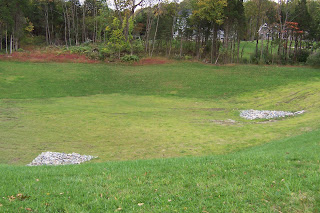How to Start a Sustainable Garden Without a Lot of Back-breaking Work
 |
| In the Texas Hill Country, just step outside or drive down any road in April and you’ll see a profusion of native wildflowers, thanks to former First Lady, Ladybird Johnson’s America the Beautiful campaign. |
When Alice asks the Cheshire Cat,
“Would you tell me, please, which way I ought to go from here?”
He replies,
He replies,
“That depends a good deal on where you want to get to.”
Lewis Carroll, Alice in Wonderland
In a similar vein, in thinking about how to create a more sustainable garden, you need to first answer the question, "What is sustainable gardening?" (I've done that for you here, but basically it's the practice of growing flowers or food in Earth-friendly ways -- using Nature's resources without using them up) and then determine where you want to go.
1. Set a clear objective. Where are you along the road to a more sustainable garden? Do you want to completely revamp how your garden functions? Or tackle just a few small changes that can be done quickly? Perhaps you’ve scoped out a single project that would make a big difference, but it needs to be done in stages. Make sure your choice(s) align with your deepest convictions and abilities; you want this to be a labor of love so that it feels rewarding and fulfilling at the end.
Set a realistic budget based on real-world, written price quotes if contractors are involved; establish milestones to keep everything on schedule; prepare for the unexpected and budget 10 – 15% extra time and money to deal with it.2. Meet the garden where you live. To build your sustainable garden, start from the ground up: Acid-loving plants in acid soil, bog plants in humic soils, lime-loving plants in alkaline soils, salt-tolerant plants by the seashore, drought-tolerant plants in hot, dry climates, mold- and mildew-resistant plants in humid regions, etc., This is what professional garden designers refer to as “the genius of place” and “right plant in the right place.” It seems obvious, but failure to respect the genius of place is why we continue to see water-hogging grass lawns in locations such as Phoenix, Albuquerque, the suburbs around Los Angeles, and the high desert regions of Colorado, Utah, Nevada, and Idaho. Plants that don’t thrive in your native soil become high-maintenance divas. You can find soil maps on the internet from the US Department of Agriculture (http://casoilresource.lawr.ucdavis.edu/soilweb-apps/ ), and state environmental protection agencies. County agencies and land grant colleges may also supply this information.
3.Know your ecoregion. Ecoregions are distinct geographic regions that contain a characteristic variety of plant and animal species, soils, watershed types, and land forms. They are important for choosing which plants to grow because plant health depends on many factors, including climate, soil type, terrain, and how water flows through the landscape. When combined with hardiness zones, ecoregions provide important clues about which plants will provide pollinator and wildlife habitat, allow rainwater to seep into the ground, and encourage micro-organisms in the soil to thrive. The Sustainable Gardening Library’s EcoRegions app combines the USDA Plant Hardiness Zones map with the EPA’s Ecoregions of North America maps.
4. Work with natural land forms. Start creating your sustainable garden with an eye towards using existing features and minimizing maintenance. It’s not only easier on the back, but also on the pocketbook.
Many of the great gardens and parks of former eras, both here and abroad, depended upon huge earthmoving projects to create “naturalistic” vistas and landscapes (Central Park, Longwood Gardens). It also took an army of gardeners to maintain them.
An opposite school of thought is represented by Andrew Jackson Downing (1815 – 1852) and Capability Brown (1715 - 1783) who took the view that the best garden designs were those that made the most of the existing terrain and natural vegetation. Critics of their designs bemoaned the fact that their gardens were indistinguishable from “looking at Nature” and offered nothing more than a sense of peace and calm – things we perhaps place a higher value on in today’s frenetic society.
5. Use what grows naturally in your area. Exercise some caution, here. These days, many of our wild spaces harbor invasive plants that have escaped from residential yards (English ivy, periwinkle, barberry, burning bush) or are the unintended consequence of erosion control (kudzu, crown vetch, Japanese honeysuckle, ice plant).
If you are unfamiliar with native plants in your area, there are innumerable lists available in books and on the internet. Visit a local public garden, arboretum, or university that maintains a native plant demonstration garden. Or, ask a staff botanist or biologist at federal and state parks, or wildlife management areas, for information.
If you prefer more excitement than an all-native garden provides, think about installing some large garden ornaments, colorful containers, or artistic structures, such as arbors, twig fences, etc. Near-natives (nativars) may supply more color and larger blooms than the native species, but will likely require more care and may not be as pollinator-friendly.
By considering these five foundational elements early on, you’ll avoid heartaches – as well as backaches – as you continue your journey towards creating a more sustainable garden.
Top Tip
Many plants that thrive in shade or partial shade can also be grown in moist sunny areas, such as these Four Ferns to Foil Deer in the Garden .

